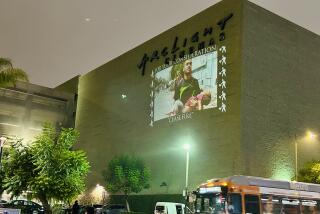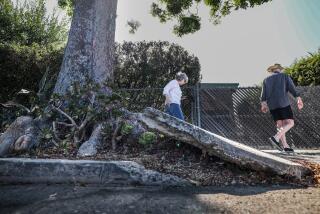At ArtWalk, chalk one up to excessive police response
- Share via
If drawing on the streets with chalk is a crime, I’d like to report a massive breakdown of civil authority in my neighborhood. I recommend a phalanx of officers in riot gear, because some of these 8-year-olds drawing hopscotch grids on the sidewalk are lawless vandals who won’t hesitate to get sassy with authority figures.
Unfortunately, this kind of thinking seems to have prompted Thursday night’s heavy police response at ArtWalk, one of downtown L.A.’s most successful community events. At least 17 people were arrested in what started out as a demonstration of support for chalk artists and turned into a brawl between Occupy Wall Street protesters and police. Was this really necessary?
Apparently, a group identifying itself as belonging to the Occupy movement was upset about a rash of arrests of people who were drawing on streets, sidewalks and buildings with chalk, so they advertised on Facebook a protest that they dubbed “Chalk Walk.” Protesters handed out chalk and encouraged people to make their own street art. This presented Los Angeles Police Department officials with three choices: They could have ignored it -- because, really, what harm can a little chalk art do? Or they could have sent a few officers down to ask people to stop. Or they could have shown up in force, sirens blazing, and demanded that the crowd disperse. You can guess which they chose. The result: Some demonstrators grew violent, objects were thrown at cops, bean-bag projectiles were fired at protesters, several people (including four officers) were injured and a handful of knuckleheads went to jail on charges ranging from vandalism to assaulting a police officer.
The LAPD has developed a very successful strategy for dealing with problem districts. One idea behind the so-called broken windows theory or its variants is to crack down hard on small crimes as a way of heading off bigger ones. Under this model, you could justify what seems like an excessive response to a crime as minor as chalk art -- what started out peaceful and chalky might have, if ignored, turned into something dangerous and spray-painty. Moreover, LAPD brass has good reason to be wary about the Occupy crowd. After police initially ignored a tent city the group set up at City Hall last fall, the encampment turned into a public nuisance that embarrassed city officials and trashed the parkland around the civic center, which has been recently repaired at heavy taxpayer expense. One can almost understand the heavy-handed response this time around.
Except that ... we are talking about chalk art, here. Media reports seem to indicate that there wasn’t any violence taking place at the protest until the police showed up. LAPD spokeswoman Norma Eisenman told The Times that chalk art on streets or private property is, indeed, considered criminal vandalism, even though it’s nearly as ephemeral as writing in beach sand -- there’s no need to send anti-graffiti crews to clean it up because it washes away with the rain or simply fades away on its own.
Let’s set aside for now the misplaced priorities of what’s left of the Occupy Wall Street movement -- for a group founded on high-minded ideals about protecting the interests of everyday Americans against the special interests that rule Washington to be wasting its time on chalk art seems to signal pretty clearly the movement’s death as a national political force. But Thursday night’s incident should be prompting some serious rethinking at police headquarters about how to respond to nonviolent protests without turning them violent.
ALSO:
Sheriff Baca’s bad badge policy
Should our Olympic athletes just go naked?
Melinda Gates’ $560-million disagreement with the pope
Subscribe to Dan Turner on Facebook
More to Read
A cure for the common opinion
Get thought-provoking perspectives with our weekly newsletter.
You may occasionally receive promotional content from the Los Angeles Times.










